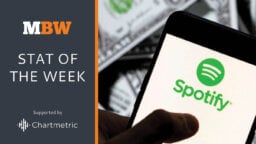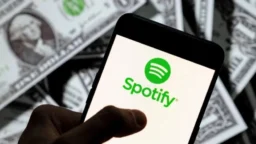Spotify delivered some good news to investors last week in the form of YoY Premium Subscriber growth: the platform’s subs were up by 7 million at the close of Q2 2021 (to end of June) on the 158m that it counted at the end of the prior quarter.
SPOT’s global Monthly Active Users, (MAU) performance, however, fell short of the guidance it published at the end of Q1.
Spotify’s global MAU count reached 365m in Q2 2021, up by just 3% – or 9 million – compared to the previous quarter (Q1 2021) when the platform counted 356m MAUs.
Spotify partly blamed this slow MAU growth on COVID-19, telling investors that the impact of coronavirus “continued to weigh on our performance in several markets” and that, in some instances, the platform has recently “paused marketing campaigns due to the severity of the pandemic”.
Secondly, Spotify cites a now-resolved “user sign-up issue” associated with an unnamed global third party platform as a reason for slower MAU growth in Q2.
“While I’m disappointed that our MAU growth was softer in the last half of Q1 and the first half of Q2, the good news is that we’ve seen that trendline reverse and all the leading indicators I’m seeing show that we are back on track”.
Daniel Ek, Spotify
During his opening remarks on the company’s earnings call, SPOT CEO Daniel Ek explained that “While I’m disappointed that our MAU growth was softer in the last half of Q1 and the first half of Q2, the good news is that we’ve seen that trendline reverse and all the leading indicators I’m seeing show that we are back on track.”
He also revealed that, “Markets like India, Brazil and parts of Southeast Asia lagged behind our expectations and we’ve also seen a slightly slower adoption rate in some of our newly launched markets”.
Ek noted: “All these regions have been hard hit by COVID”.
CEO Daniel Ek and CFO Paul Vogel were quizzed on the company’s earnings call last week. Here’s what we found out:
1) SPOT’s missed MAU guidance is just a “bump on the road” and not related to price increases, or competition…
Ek and Vogel were asked by an analyst early on in the Q2 earnings call to explain the third-party platform issue cited as having had an impact on MAUs
In addition to that, they were asked how confident they are that the missed guidance is not related to competition or slower uptake due to price rises, which have been implemented in multiple markets, including the US, Europe and the UK.
In answering the first question, Vogel revealed that the third party platform issue “was an issue with email verifications between [SPOT] and the third party”. He didn’t reveal who the third party was.
“We made a change that was not quite constant enough and we believe it had an impact on growth,” he explained. “The estimate right now is that it was about 1 to 2 million of MAU growth that was impacted by the friction created by this email verification change. It’s since been corrected and should not be an impact in Q3.”
Regarding competition, saturation and price rises, Ek noted that “the underperformance we saw [was] in emerging markets and not western markets”.
“To the question of saturation,” he said, “those are also in markets where we are in much earlier stages of growth, rather than the sort of bigger markets like the US and most of Europe as well”.
“If I’m disappointed about anything it’s probably just we should have seen it coming more in the forecasting.”
Daniel Ek
Added Ek: “We feel really good about where we are from a competitive standpoint. We see a strong demand for Spotify across the world, but obviously, as we said going into the year, 2021 will have a higher degree of variability and especially for a global company like Spotify, where we have so many regions that are all in different stages of maturity.
“That’s what you’re seeing here and just to contextualise it even further, it’s really been playing out over a quarter so I look at it more as a bump on the road than anything else and because we had such a strong 2020 year. If I’m disappointed about anything it’s probably just we should have seen it coming more in the forecasting but it’s obviously very difficult to forecast these things, but I I feel really really good about our long term growth prospect and that hasn’t changed.”
Later on in the call, Vogel explained that Spotify’s Average monthly Revenue per Subscriber (aka ARPU) is expected to increase in “the back half of the year”, with price rises cited as playing a role in this predicted uplift.
SPOT’s ARPU landed at €4.29 in Q2, down 3% year-on-year, but flat at constant currency.
2) Daniel Ek claims that the days of Spotify’s ad business “accounting for less than 10% of our total revenue are behind us…”
Daniel Ek may have been “disappointed” about Spotify’s MAU growth in Q2, but he was bullish about the company’s Advertising business, and for good reason.
SPOT’s Ad-Supported Revenue outperformed its forecast, reaching $275 million in Q2. That was up 110% YoY and up 28% compared to the prior quarter (Q1 2021), when the company generated $216 million in ad-supported revenue.
Ek made a couple of interesting comments about the company’s ad business on the company’s investor call.
In his opening remarks, he said of SPOT’s ad business, “Admittedly, this is an area where I previously didn’t spend much time, but it’s becoming impossible to ignore.”
He added however, that “it’s now safe to say, it’s becoming a second big revenue driver for Spotify”.
So what’s driving Spotify’s healthy ad business?
The company’s Ad-Supported MAUs only grew by 2 million in Q2 – from 208 million in the prior quarter (Q1 2021) to 210 million – so at the centre of this growth, according to SPOT, is its podcasting strategy.
“Admittedly, this is an area where I previously didn’t spend much time, but it’s becoming impossible to ignore.”
Daniel Ek
According to Ek, “podcast revenue was up over 627% year-over-year, or nearly 200% on an organic basis, and the continued outperformance is currently limited only by the availability of our inventory, which is something we’re actively solving for”.
Spotify doesn’t provide a breakdown of how much revenue its podcast business is actually generating, but according to the company’s shareholder letter, “The strength in Ad-Supported Revenue was led by our Direct and Podcast sales channels … along with contributions from the Megaphone acquisition”. Podcast ad-tech platform Megaphone was bought by Spotify for $235m in November 2020.
Ek is now so confident about the potential of the company’s ad business, he told investors and analysts that “the days of our ad business accounting for less than 10% of our total revenue are behind us”.
He added: “Going forward, I expect ads to grow to be a substantial part of our revenue mix.”
3) Daniel Ek says that “The opportunity in front of [spotify] is to get to more than 50 million creators”…
At Spotify’s ‘Stream On’ event in February, Daniel Ek stated that by 2025, Spotify could have “as many as 50 million creators on our platform, whose art is enjoyed by a billion users around the world”.
He reiterated this objective last week, explaining that the platform Spotify is trying to build “is all about moving from 8 million to 50 million creators and from 400 million to more than one billion users on our platform”.
He was asked about this “billion user opportunity” on the company’s earnings call and specifically what “key investments” SPOT would need to make to make that dream a reality.
Ek didn’t specify a value of investment required or any specific areas of investment to achieve that target, explaining that Spotify had “grown in the past few years from about one million creators to now more than eight million creators”.
“The opportunity in front of us is really to get to more than 50m creators.”
Daniel Ek
“But the opportunity in front of us is really to get to more than 50 million creators,” he added. “And as part of that, it’s really all about getting those audiences of those 50 million potential creators to start listening to that content, becoming super fans, and creating more and more tools for the creators and fans to start engaging with each other, turning that engagement into monetization opportunities and so on.”
Added Ek: “So that’s really the kind of main strategy, and a lot of that comes down to a combination of platform improvements, discoverability of just being able to showcase and seeing new content.
“And then, obviously, the content team and onboarding new creators and finding compelling ways to get creators to feel like Spotify is the number one platform.
“When that happens, it is a flywheel that turns into more creators turns into more users and more users turns into more creators and so on and so forth.”Music Business Worldwide





